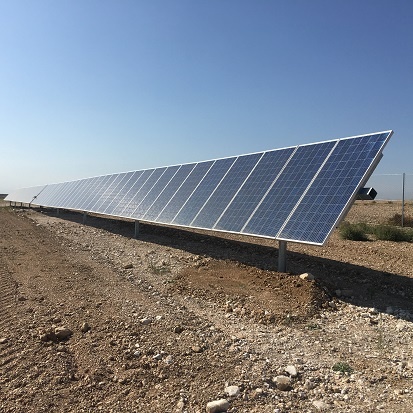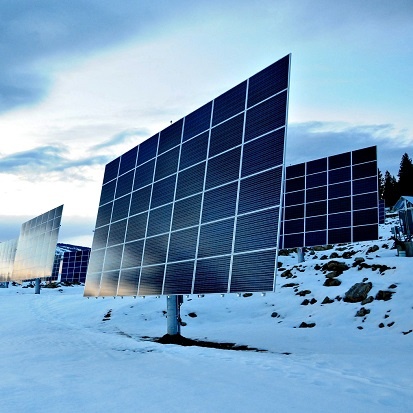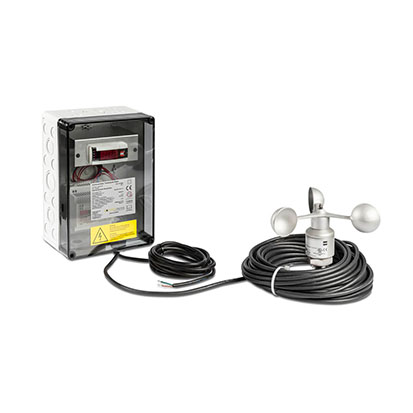SELF-SUPPLY OF SOLAR ENERGY IS POSSIBLE – WITH PHOTOVOLTAIC TRACKING SYSTEMS
Future’s energy is generated where it is consumed. A vision which has already become reality for some private households and medium-sized companies. Small, decentralised solar energy production units, energy storage devices and a battery management system, can help you to a large extent to become independent from the public power grid and the constantly rising electricity prices. First systems for self-supply prove: It works.
While the change of energy policy is being debated publicly, more and more consumers are taking their electricity supply into their own hands. They thereby follow two objectives: the produced solar energy is environmentally friendly, and it provides them with tangible financial benefits. With an investment of less than 25,000 Euro a single-family house with office and electric car can completely cover its own demand with self-produced solar energy – and freeze the electricity price at today’s level for about 25 years. The first MSS1 systems are already running and their yield shows: it is paying off.
The problem: Unbalanced load profile
On the one hand, self-supply of private houses, apartments or whole companies with solar energy previously failed, due to the issue of storing the generated energy. On the other hand, the unbalanced load profile of fixed photovoltaic installations opposes the targeted ideal of using the generated energy immediately. Both problems can be elegantly solved by using photovoltaic tracking systems. For both the efficient storage and the immediate consumption, a balanced load profile is necessary – in other words: a constant production of solar energy the whole day long.
As an explanation: Fixed photovoltaic systems reach their production peak around midday but produce relatively little energy before and after. This means: In the morning and in the evening, when a normal household really needs a lot of electricity, fixed systems usually do not provide enough energy. This is different with tracking systems such as the MLD2 tracking systems from DEGER (MLD stands for Maximum Light Detection): They usually provide enough solar energy for direct consumption even during these times of day.
The second significant factor when using a self-supply system are the electricity storage devices. They supply the consumer with energy even when the photovoltaic modules are not generating enough electricity or no electricity at all.
Tracking conserves electricity storage devices
For storage, too, tracking systems have one decisive advantage. The batteries used as energy buffers can be recharged much more sparingly with a constant input than with short, high voltage peaks, which are typical for fixed systems. The system thus requires less battery capacity – which significantly increases the life span of the electricity storage devices. A rule of thumb is: MLD tracking saves about 30 percent battery capacity.
In addition, the effect already described applies: When the sun is in the sky – which, by the way,also applies for days with an overcast sky – tracking systems generally supply enough energy for direct consumption. So the batteries are not used during these times. Both have a positive effect on the profitability of the whole system.
Use excess energy sensibly
The battery management system enables the user to control the self-supply system according to his individual wishes and requirements. First, the solar energy which is not directly used is routed into the electricity storage devices. When the batteries are full, the excess energy can be fed into the power grid or used for another purpose – e.g. for the treatment of waste water or to power a heating system. This, too, is controlled by an excess manager in the control cabinet according to the demand or the user’s priority.
Assuming that there is generally still a connection to the public power grid, the battery management system can be set in such a way that the batteries are only discharged by a maximum of 50 percent. Once this minimal value has been reached and there is no directly-produced solar energy available, the system automatically obtains electricity from the power grid. The battery buffer can be set higher or lower. 50 percent make sense, considering that during power cuts the system should provide the household or the company with electricity even when solar energy is not directly available.
The way to a self-sufficient energy supply
Someone who decides to use a self-supply system usually does not want produced electricity to be fed into the power grid and profit from the feed in tariff. Even more so because the days of feed in tariffs are numbered – a trend which has already begun worldwide. In Germany they will drop below 10 Cents per kilowatt hour in the near future; today the production costs for solar energy using tracking systems are already at approximately 10 Cents per kilowatt hour.
The direction is obvious: The users of such systems mainly want to become independent from public power grids and the rising energy costs. A self-sufficient power supply can be a means of future security, especially for small and medium-sized companies, which do not benefit from the attractive major customer tariffs of the energy suppliers. They can soundly calculate their energy costs on the long term – and freeze them at today’s level permanently. That means: Their competitiveness grows with every price increase by the public energy suppliers.
There is no doubt that the electricity prices will not stay at the current level. The Karlsruhe Institute of Technology estimated in a report of mid-May 2012, that the electricity prices in Germany will increase by 70 percent until the year 2025. A figure which, by the way, applies for major customers. For private households and smaller companies the price increase will surely be even higher.
Positive energy balance
In the meantime, the DEGER test system, which was installed in autumn 2011, and other systems, which have been installed since then, have produced reliable yield and consumption measurements. They show: 22 square metres of tracked solar module surface cover around 115 percent of the energy needed by a single-family house with office and two electric vehicles.
In detail: In the first 5 months of the year 2012, the test system produced around 3,000 kilowatt hours of solar energy. The energy consumption of the connected household including office and electric vehicles was about 2,600 kWh during the same period.
The positive energy balance is seen in the relationship between electricity obtained from the power grid and the electricity fed into the grid: Between January and May around 610 kWh were taken from the power grid. In the same time period 930 kWh were fed into the grid.
The test system features 18 solar modules type Sanyo 240 with a total output of 4.320 watt peak. Within the first complete calendar year it produced 7.525 kilowatt hours of solar energy – a sensational outcome, which significantly exceeds even the DEGER’s expectations. Certainly a part of this is due to the location: the system has free visibility from the eastern to the western horizon. And it is usually very seldom foggy in this region. Thus, the site not only delivers enough solar energy for its own consumption, it also supports the warm water treatment of the house to a considerable extent.
Notable detail: Both electric cars travelled a total of around 6,000 kilometres during the first measurement period. To achieve this, they consumed approximately 900 kWh electricity at a purchase price of about 200 Euro. When taking this used energy out of the calculation, it would not have been necessary to obtain any electricity during the whole measuring period. At the same time, though, 400 litres of petrol was saved by the cars which would have cost more than 600 Euro at the current prices.
A functioning complete system for self-supply, including installation, costs less than 25,000 Euro. On this basis users can freeze their electricity price at the current level for the next 25 years. This calculation includes all costs – from the installation itself and the costs of financing, as well as maintenance and service including costs for spare parts over a period of 25 years.
The MLD principle
The MLD or Maximum Light Detection Principle is based on the accurate tracking movement of solar modules to the most energy-rich positions. This is due to the patented control module. It continually measures the intensity and angle of incident light beams and, based on these measured values, constantly realigns the system’s solar modules according to the current light conditions. This enables modules to generate energy from diffuse light which penetrates through clouds or reflects off water and snow surfaces. This process generates on average a surplus yield of 45 percent compared to fixed solar modules.
1 MSS = Maximum Solarpower Storage
2 MLD = Maximum Light Detection
Information for editorial offices:
Image material in printable quality is available for downloading here at the end of the press release. However, feel free to also request image material from Herbert Grab, Tel.: +49 (0) 7127-5707-10, e-mail: herbert.grab@digitmedia-online.de.
About DEGER (www.DEGER.biz):
DEGER is the leading manufacturer with the world’s largest product portfolio for single and dual axis solar tracking systems. Its market position is based on the unique, patented “Maximum Light Detection” or MLD technology developed by Artur Deger. This technology makes it possible to increase the yield of solar power plants through the use of “intelligent” control. In this case the MLD sensor constantly aligns the connected solar modules with the point in the sky that provides the greatest energy. Thus solar systems guided with MLD achieve a 45 percent greater yield on average than fixed systems – during peak periods this value is even considerably higher. With more than 50,000 systems installed in 51 countries, DEGER is world’s market and technology leader. The company offers every solution relevant to the product – from development and planning to production and sales, all the way through to maintenance and repair.
Nearly 400 employees currently work for DEGER at the company’s headquarters in Horb, its branch offices and suppliers. The company was founded in 1999 and in 2001 it was distinguished with the Baden-Württemberg Inventors Award for the MLD sensor. In 2005 DEGER opened its first branch office in Spain, in 2009 branch offices followed in the USA and Greece, and in summer 2011 production began in Australia. DEGER produces in Germany, Australia, Canada and in the USA. The company’s business is managed by Artur Deger.
You can’t always rely on the weather – but on an intelligent control system from DEGER for sure.
Customer contact:
DEGERenergie GmbH
Industriestraße 70
D-72160 Horb
Tel.: +49 (0) 7451-539 14-0
Fax: +49 (0) 7451-539 14-10
e-mail: sales@DEGERenergie.com
Press contact:
Herbert Grab
digit media
Schulberg 5
D-72124 Pliezhausen
Tel.: +49 (0) 7127-5707-10
e-mail: herbert.grab@digitmedia-online.de



